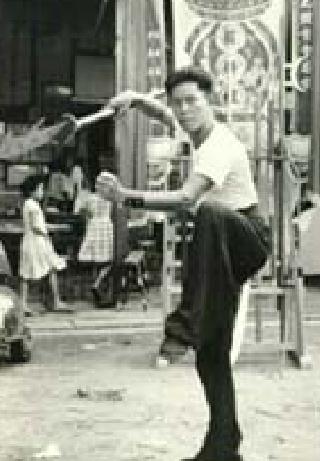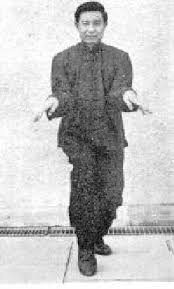INTRODUCTION TO WING CHOON KUNGFU
PREFACE

My first sifu, Sifu Lai Chin Wah, more popularly known as Uncle Righteousness
Sometime in 1975 John Malone and his family came to Malaysia for a holiday. While at home John had previously heard from my boyhood friend, Soon Hoe Choon, of my fascination with kungfu. So John wanted to learn some kungfu from me. I selected to teach him Wing Choon Kungfu because it is probably the best style of kungfu for his situation where he could acquire as much and as effectively as possible some martial art techniques within a relatively short time.
John was not impressed when I first showed him some Wing Choon patterns because these patterns were actually very prosaic and simple in appearance, vastly different from the spectacular movements he had learnt in Taekwondo. However, as I explained the significance and demonstrated the effectiveness of these bafflingly simple patterns, John's enthusiasm was greatly aroused.
Specially for John I selected representative patterns from Wing Choon Kungfu to devise a new, comprehensive set so that he, while not having sufficient time to learn Wing Choon Kungfu the orthodox way, could still acquire sufficient Wing Choon techniques to appreciate what Wing Choon Kungfu is, and to use it for combat if needed. Although the set is short, it comprises many of the best patterns in Wing Choon Kungfu, and is the one that is reproduced in Chapter 3.
Although John progressed very rapidly, his stay here was too short for him to practice as adequately as desired. In order that he might have some reference when he practiced at home as well as to further his understanding of kungfu, I proposed to send him series of photographs and explanatory notes. This idea inspired the first notion of writing this book. I reasoned that perhaps I could contribute more to the study of Wing Choon Kungfu by compiling and enlarging my notes into a complete, comprehensive manual so that other interested people might also read it.

My second sifu, Sifu Chee Kim Thong, the living treasure of the People's Republic of China
My first introduction to Wing Choon Kungfu occured when I was only a small boy. I was then learning Southern Shaolin Kungfu from my first kungfu teacher, Sifu Lai Chin Wah, a master well-known for his fighting skills as well as his Lion Dance performance. One of Sifu Lai's kungfu friend was Sifu Choe Hoong Choy, a noted Wing Choon master. Wing Choon Kungfu was virtually unknown then, and Sifu Choe had no intention of popularizing it. It was only recently that Wing Choon Kungfu became popular, after its spread by the late Wing Choon master Yip Man of Hong Kong, and its publicity by the celebrated Bruce Lee. Previously, even kungfu masters of other styles had only a vague idea of what Wing Choon Kungfu actually looked like, and merely knew that it was vastly different from "orthodox" kungfu as represented by Hoong Ka Kungfu which was the most popular then.
Much enticed by its scarcity and very eager to know a different style of kungfu for the one I was accustomed to, I persuaded Sifu Choe to teach me. It must be of interest to point out that kungfu masters were generally conservative in their thinking, and many would consider leaving another style or another master an act of disloyalty to the original style or master. Fortunately I was not restricted by such convertism. Nevertheless, I did not learn from Sifu Choe until many, many years later when Sifu Choe asked me to teach his disciples Lion Dance, a feature of Chinese culture closely related to kungfu. I also learned osteopathy, or kungfu medicine, from Sifu Choe.
Meanwhile, I learned kungfu from two other masters -- Sifu Chee Kim Thong who puzzled the West by sitting in a lotus position and receiving three brick-breaking Karate chops on his head from a Black-Belt challenger, and Sifu Ho Fatt Nam who descended directly from the southern Shaolin Monastery. Sifu Ho was the chosen Successor of Sifu Yang Fatt Khuen, the disciple of the Venerable Jiang Nan, a Shaolin monk who escaped from the Monastery when it was burnt by the Manchurian army. To give an idea of how solemnly old masters selected their disciples to bequeath their arts, it is heartening to note that the Venerable Jiang Nan spent fifty years just to look for a suitable successor to nurture him.

My third sifu, Sifu Ho Fatt Nam, the Third Generation Successor of the southern Shaolin Monastery
Thus, when I eventually learned Wing Choon Kungfu, I already knew other styles, including its parental Shaolin Kungfu. This advantage not only provides me with a good basis for comparison, but also enables me to learn with insight and perspective.
In this book I present a methodical, comprehensive introduction to Wing Choon Kungfu, starting from the basic to advanced levels. I begin with a historical and comparative survey of kungfu, followed by a deliberation on the special features of Wing Choon Kungfu. Then I show, with numerous illustrations, how a Wing Choon set is performed, and how to use its patterns for combat. I also describe various steps to prepare oneself for effective free sparring. There are explanations on Wing Choon skills like sticking-hands and inch-force, on wooden dummy exercises, and on classical Wing Choon weapons. Finally I answer quarries that readers may have concerning Wing Choon Kungfu as well as kungfu in general.
This book is a self-taught manual, written with much thought for the reader practicing without a personal instructor. Skills and techniques therefore are described in detail in easily readable language, and fully illustrated whenever necessary. On the other hand, those who are already practicing Wing Choon Kungfu will find this book a valuable reference. Many items described in this book are fairly advanced, and probably appear in print the first time, as Wing Choon masters in the past were generally reserved in revealing their advanced knowledge. I am not sure whether some conservative masters may be displeased with my liberal attitude in my explanation of Wing Choon skills and techniques in this book. My contention is that the purpose and meaning of kungfu training in today's modern, law-abiding world are quite different from those of an ancient society where revealing kungfu secrets might mean defeat or even death in fighting which happened not infrequently. In this connection I can draw inspiration from the philosophy of both Sifu Ho and Sifu Choe, who often expressed their desire for their disciples to be better than them themselves.
Besides the intensive treatment of the subject, this book is also extensive, as it covers all important aspects of Wing Choon Kungfu. It is therefore very helpful to kungfu exponents of other styles or martial artists of other systems who wish to have some sound, thorough knowledge of Wing Choon Kungfu for comparison but lack the time or opportunity to acquire it. I aim to make this book not only informative but also enjoyable. The reader, I hope, will find it as pleasant to read as it is useful for serious study.
Grandmaster Wong Kiew Kit,
15th July 2019.

My fourth sifu, Sifu Choe Hoong Choy, the Patriarch of Choe Family Wing Choon
LINKS
Introduction to Wing Choon Kungfu
Courses and Classes




